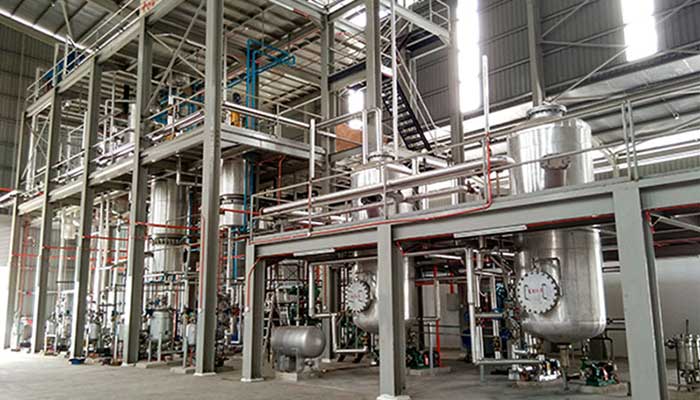
The short path distillation plant consists mainly of a cylinder, an inner condenser and a rotor. The inner condenser is in the center of the evaporator, and the rotor with membrane scraping system rotates between the evaporator and condenser. The distillation process is: the material is added from the top of the evaporator, and is continuously and evenly distributed on the heating surface through the liquid distribution device on the rotor. A film scraper scrapes the product into a very thin, turbulent liquid film in the best-supplied short-run distillation plant.
During this process of distillation in the short path distillation plant, the light molecules escaping from the heating surface, basically without collision, go to the condenser to condense into liquid and flow down the condenser tube and are discharged through the discharge tube located at the bottom of the evaporator; the residual liquid, i.e., heavy molecules, is collected in the circular channel under the heating zone and then exits through the side discharge tube.
In fact, distillation is a common mode of operation in the chemical unit operation, mainly to achieve the separation of mixed liquids, including atmospheric pressure. Distillation and reduced-pressure distillation, mainly the use of mixed liquids in the volatility of each component of the different degrees to achieve the purpose of separation. In other words, the light component of the liquid is separated when the saturated vapor pressure is greater than the pressure of the system, the material can be separated, so the short path distillation of the liquid can be separated. The lower the pressure of the distillation plant (higher the vacuum), the easier it is to separate.
Short path distillation is also molecular distillation, and the condensing area should be greater than the evaporating area in order to achieve good results for molecular distillation purpose, but due to the structure of the equipment, it is impossible for the actual equipment to achieve the ideal molecular distillation conditions, only to approach or simulate the Molecular distillation, which is the main reason for the name. It is based on the introduction of the concept of saturated vapor pressure and the average free range of molecules on the basis of ordinary distillation, the light-component molecules separated from the main body of the liquid phase. to capture accumulation as quickly as possible, i.e., the distance from the heating surface to the condensing surface is equal to or less than the free range of escape of the light component molecules.
In the process of using the short distance distillation plant, there are many factors that will affect its separation ability, one is the speed of diffusion of the light component in the mixed liquid from the liquid phase body to the heating surface; the second is the saturated vapor pressure of the light component and the vacuum level of the system; the third is the speed of escape of the light component molecules to capture and condensation accumulation (i.e., the distance from the heating surface to the condensing surface).
According to the above can be seen in the short distillation distillation, in order to increase the diffusion rate of the light component, can be used to scrape the film type, the The material uniformly scraped in the heating surface into a very thin film, so that the light component of the mixed liquid from the liquid phase of the main body to the evaporation surface of the diffusion rate to achieve Maximum, very short diffusion times. Precise placement of the built-in condenser inside the device so that the distance between the heating and condensing surfaces is less than or equal to the mean free flow of the light component molecules.
